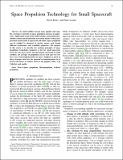Space Propulsion Technology for Small Spacecraft
Author(s)
Krejci, David; Lozano, Paulo C
DownloadKrejciLozano_PropSamllSat_ProcIEEE2018presub.pdf (4.945Mb)
OPEN_ACCESS_POLICY
Open Access Policy
Creative Commons Attribution-Noncommercial-Share Alike
Terms of use
Metadata
Show full item recordAbstract
IEEE As small satellites become more popular and capable, strategies to provide in-space propulsion increase in importance. Applications range from orbital changes and maintenance, attitude control and desaturation of reaction wheels to drag compensation and de-orbit at spacecraft end-of-life. Space propulsion can be enabled by chemical or electric means, each having different performance and scalability properties. The purpose of this review is to describe the working principles of space propulsion technologies proposed so far for small spacecraft. Given the size, mass, power, and operational constraints of small satellites, not all types of propulsion can be used and very few have seen actual implementation in space. Emphasis is given in those strategies that have the potential of miniaturization to be used in all classes of vehicles, down to the popular 1-L, 1-kg CubeSats and smaller.
Date issued
2018-03Department
Massachusetts Institute of Technology. Department of Aeronautics and Astronautics; Massachusetts Institute of Technology. Space Propulsion LabJournal
Proceedings of the IEEE
Publisher
Institute of Electrical and Electronics Engineers (IEEE)
Citation
Krejci, David, and Paulo Lozano. “Space Propulsion Technology for Small Spacecraft.” Proceedings of the IEEE, vol. 106, no. 3, Mar. 2018, pp. 362–78.
Version: Author's final manuscript
ISSN
0018-9219
1558-2256